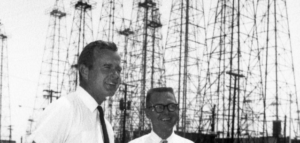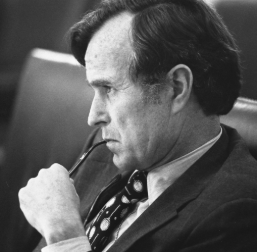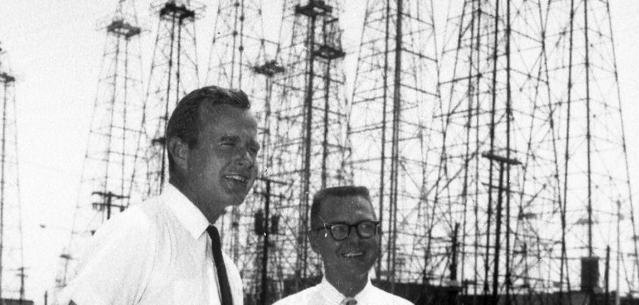Some may wonder at the outpouring of affection from the CIA for the late President George H. W. Bush. Bush is not merely admired at the spy service. He is, in the words of one his successors, John Brennan, “revered.”
As a former Director of CIA, President George H.W. Bush is a revered figure among past & present members of CIA’s family. Accordingly, previous Directors & Deputy Directors of CIA issued a joint statement of respect, admiration, and appreciation for his selfless public service. pic.twitter.com/vV9il2A8tn
— John O. Brennan (@JohnBrennan) December 2, 2018
The reasons for Bush’s inclusion in the “CIA family” are not obvious. He was never a CIA operations office or analyst. He only served as its director for 14 months in the 1970s, the lowest point of the agency’s 71-year existence. The agency experienced no great triumphs in that period, only an overdue and humiliating Congressional investigation into its abuses of power.
Yet in 1999, the agency named its Langley compound after Bush. And now the CIA mourns him like no other director since Richard Helms, “the gentlemanly planner of assassinations,” who died in 2002.
Certainly, Bush’s defense of the agency prerogatives under Capitol Hill interrogation in 1975-76 was both stout and deft. HIs 1992 pardon of four top CIA officials who conspired to fund an illegal counterrevolutionary war in Central America by illegally selling arms to arm to Iran in defiance of Congress is remembered and appreciated. Bush may well have saved Dewey Clarridge, Clair George, Alan Fiers, and Joseph Fernandez from jail time. As law-breaking professionals, the leaders of Langley like nothing better than a “Get Out of Jail Free” card.
Salty Code Names
The reasons for Langley’s approbation of Bush run deeper and longer than his overt support of the CIA. Declassified records show that as an aspiring Texas oil man in the 1950 and 1960s, Bush put his oil drilling firm, Zapata Off-Shore, at the disposal of the Central Intelligence Agency. The firm’s code name, according to declassified CIA memos, was WUSALINE.

The WUBRINY/WUSALINE documents were declassified by the JFK Assassination Records Review Board in 1998. They were discovered by Bill Simpich, a retired civil rights litigator and JFK author in San Francisco. They areavailable in the CIA Cryptonym Datatbase of the Mary Ferrell Foundation’s online archive.
They show that as early as 1963, Bush’s business partner in Zapata, Tom Devine, was a “cleared and witting commercial asset,” with an equally salty cryptonym, WUBRINY-1.
Zapata’s CIA connection has been reported before. Ann Louise Bardach, author of several books about Cuba, writes that Zapata Offshore played “a useful role during the Bay of Pigs invasion by allowing its oil rigs to be used as listening posts, and again during the Cuban missile crisis. Barron’s magazine in 1988 identified Zapata as “a part time purchasing front for the CIA’.”
Fabian Escalante, a Cuban intelligence official and author of several books about Cuba’s long-running war with the CIA, asserted that Bush raised money for Operation 40, a shadowy CIA outfit that allegedly conducted assassinations and terror attacks on Cuban targets. The charge is unproven.
While no one document states the WUSALINE was Zapata Off-Shore, the information in five documents together suggest it probably was.
In April 1963, WUBRINY-1 reported that a Haitian government official had brought a well-connected geologist named George DeMohrenschildt to “the WUSALINE office.” The informant reported the substance of his conversation to CIA headquarters”on a sterile line.” Neither the source nor the company are identified in the memo.
But, as I will show, DeMohrenschildt made Bush’s acquaintance at some point. And this 1975 memo describes Tom Devine as “a former Agency staff officer” who had been cleared in June 1963 for “cleared and witting commercial asset for Project WUBRINY,” as well as “a personal friend and informal foreign policy adviser for Representative George Bush of Texas.”
So it seems that when Devine was Bush’s partner in Zapata in 1963, he worked in the WUSALINE office. Unless Devine’s office was located in another company, Zapata was WUSALINE.
(DeMohrenschildt, besides having superb connections in the Haitian government, was a personal friend of Lee Harvey Oswald, the accused assassin of President Kennedy. As congressional investigators pressed DeMohrenschildt in 1976 for what he knew about Oswald–which was a lot–he contacted CIA director Bush for help. It’s an intriguing story that I will tell in my next post.)
Read the document: “Messrs George Bush and Tom J. Devine”
‘Bush of the CIA’
It is not surprising, or necessarily nefarious, that Bush’s company was an asset to the agency. Several of Bush’s Yale classmates served as senior officials at the agency, including James Angleton and Cord Meyer. Bush wholeheartedly supported the agency’s operations against the Soviet Union and communist forces around the world.
The available evidence does not show that Bush conceived or organized covert operations. The various conspiracy theories linking to Bush to JFK’s assassination are baseless, in my opinion. The truth is that Zapata provided support and intelligence to the CIA operations officers.
Bush’s connection to the CIA was known to known to FBI director J. Edgar Hoover On November 29, 1963, a week after the assassination of President Kennedy, Hoover told the State Department that “Mr. George Bush of the Central Intelligence Agency” provided information about the reaction of Cuban exiles in Miami.
Read Hoover’s memo: “George Bush of the Central Intelligence Agency”
When the memo surfaced in the 1988 presidential campaign, the CIA took the rare step of commenting publicly. The agency claimed that the document referred to another CIA employee named George Williams Bush.
But that was just a cover story to protect the confidentiality of the WUBRINY/WUSALINE project. The former employee came forward and stated, under oath “I am not the George Bush of the Central Intelligence Agency referred to in the memorandum.”
In the 1998, the CIA told the JFK Assassination Records Review Board that it “had no association” with George Herbert Walker Bush “during the time frame referenced in the memo.” That carefully parsed statement does not exclude the possibility that the CIA had an association with Zapata Off-Shore.

In November 1975 President Gerald Ford asked for the resignation of CIA director William Colby and named Bush to succeed him. That’s when the deputy director of the agency learned of Bush’s “prior knowledge of the now terminated Project WUBRINY/LPDICTUM which was involved in proprietary commercial operations in Europe.” Maybe the agency had “no association” with Bush in 1963, but he clearly knew about at least one covert CIA operation and he was business partners with a “cleared and witting” asset.
The purpose of LPDICTUM is unknown. What is certain is that long before George Bush reached the top of the CIA he was familiar with the agency’s Cuba operations and its proprietary corporations. He was not exactly a newcomer.
Bush and the CIA: A Six Part Series
- Bush: Prudent Statesman as Ruthless Spy
- Declassified Records Show Bush’s Oil Business Was Probably a CIA Front
- JFK Witness Sought Help of CIA Director Bush
- Bush as Director
- Bush and the ‘October Surprise’
- Bush and the Iran Contra Conspiracy



